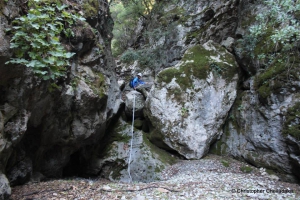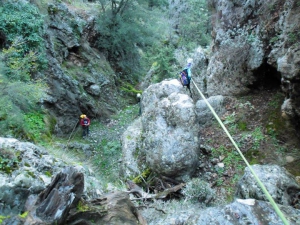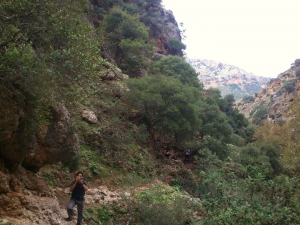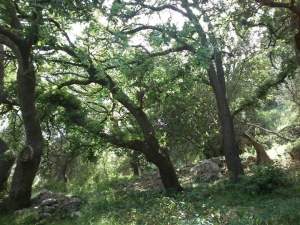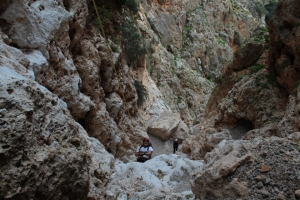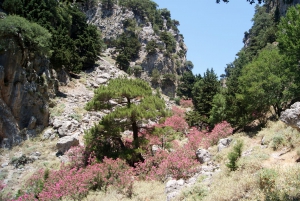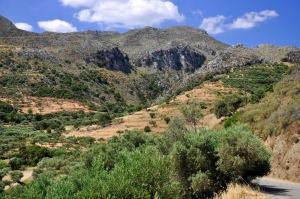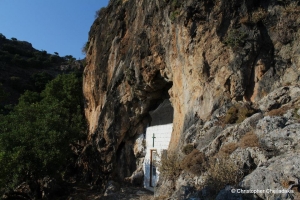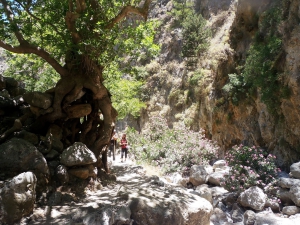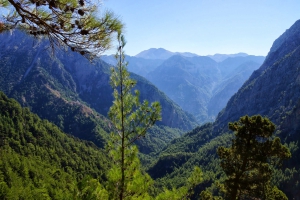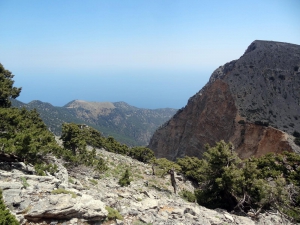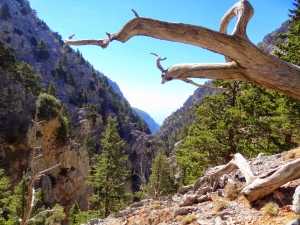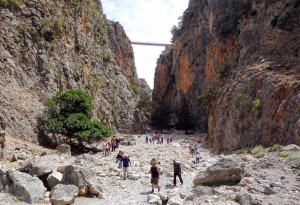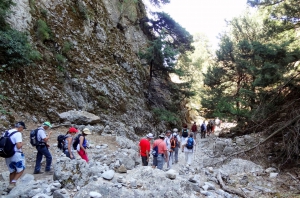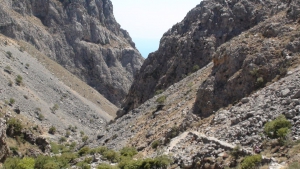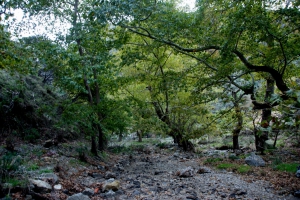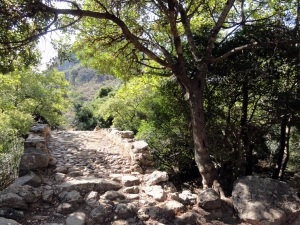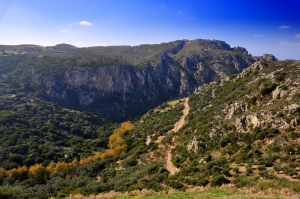The Gorge of Tromarissa is located near the village Zourva and it is said that it gets its name after the myths about fairies and goblins that scared passersby at the position where we meet the spring of Tromarissa (tromazo means get scared in Greek).
Between the villages Zourva and Meskla we meet one unknown canyon, one of the many of the region, which is called Lagos. Its entrance is located west of the village Zourva and ends in the village Meskla, at the bridge of the village, just before merging with the river Keritis.
Pigaida is a long wooded gorge with very narrow passages ending at Zourva. Along its course there are several descents that need rope and make its crossing harsh.
The Gorge of Cyclamen or St George Gorge starts from the settlement Aletrouvari (altitude 300m), passes east of the village of Agios (St) Georgios and ends at the village Vandes (altitude 50 m).
The Gorge of Katsouna, near Vrysses, is believed to be the Xenia Street of Herodotus, according to who the guests of ancient Pergamos arrived through here in order to not have visual contact with the forts of the town. The length of the gorge is about one kilometer and starts from Vrysses to reach the entrance of the ancient city.
At the furthest tip of Akrotiri Cape there is the gorge of Diplochachalo. It is located close to the village of Chordaki, on the way to the famous beach of Stefanou. This is a small, stunning and purely technical canyon with 6 descents, 2 of which are quite high. It starts just below the quarry that dominates the area.
The small piney gorge of Keratida starts above Koustogerako and after 2 hours of trekking meets the seaside E4 trail that connects Sougia to Agia Roumeli. Initially the course is on the side of the gorge. The downhill is steep and we have to be careful, as the gorge is inhospitable.
Maganistra gorge starts from the deserted settlement of Pateriana and ends at Lousakies after 3 km. Its sides are the peaks of Kouvara and Profitis Ilias. There is water flowing till late spring and course inside it is of medium difficulty.
At the lowest point of the ruined village Kolokasia, Sfaki Provice, at the church of the Virgin Mary starts forming a stream. The stream collects the water of the village. After crossing the olive grove of the village it turns to a small, but rugged, gorge called Rechtas or Rektas. Its name means waterfall in the local dialect. A few meters after the start the gorge it forms, indeed, a spectacular waterfall about 20 meters high.
Half an hour above the archaeological site of Lissos, in a totally secret position called Lichnou Laki there is a small and very beautiful canyon. The gorge is located in the district of Selino, below Prodromi village, south of Chania and its entrance is accessed by a dirt road that runs from the village (to the south). The very small canyon is quite green and is divided into two different sections. The first section is dominated by lentisks, junipers and oaks and the second is covered by pine trees despite the destructive fire that had previously burnt the region.
The gorge of Agia Irini is on the west side of the White Mountains, with many vertical passes. It gets its name from the homonym village located near the entrance, 46 km from Chania. Its length is 7.5 km and its crossing takes three hours. The gorge ends up in the seaside village of Sougia.
The Samaria Gorge is the longest trekking gorge in Europe and also the most famous of all. Thousands of tourists flock here daily in the summer season to walk from the top to the bottom. For many visitors, it is the sole purpose of their visit to Crete. The length of the gorge reaches 18km and takes almost 4-7 hours to hike from Omalos to Agia Roumeli, depending on trekking speed.
Gorge Klados is one of the most dangerous and inaccessible gorges of Crete. The top (starting point) of the canyon is located at position Kokkinovari in a steep slope, 90-100 meters high. The very loose and steep terrain makes access impossible even with technical equipment.
The gorge of Eligia is wild, long and impressive. The trail to reach the gorge's bed starts in Agios Ioannis village in Sfakia (780m altitude, 92km from Chania). After hiking for 3.5 hours in the gorge ou reach Agios Pavlos beach, which is full of pine trees, and then you need 1 more hour to the west to reach Agia Roumeli.
The deepest gorge in Chania is the gorge of Aradena. The 138-meter-deep gorge is ideal not only for sightseeing or hiking but for bungee jumping as well. Trekking inside the canyon till the exit on the majestic Marmara beach is an unforgettable experience for those who attempt the descent of the canyon.
Imbros Gorge is located in the province of Sfakia and is the third most visited gorge in Crete, following Samaria Gorge and Agia Irini by Sougia. The scenery is beautiful and the low difficulty makes the descent of Imbros ideal for families with children. The length of the gorge is 11 km and the course lasts 2-3 hours.
Kallikratis is a relatively small gorge in the southeast region of Lefka Ori (White Mountains) in Chania Prefecture. The gorge connects the mountainous pasture lands with the lowland villages. It is a very pleasant walk, offering great views and rare flowers, but is not very popular with tourists. The Kallikratis Gorge together with the Asfendou Gorge can be a full day’s excursion.
The gorge of Topolia is located at West Crete and it runs along the road leading to Elafonissi. The canyon actually starts near the village Strovles at an altitude of 450m, and exits near the village Topolia, at an altitude of 150m.
Sirikari is located 55km west of Chania and 17km south of Kissamos, in a lush green area with canyons and water streams. The road to Sirikari is paved and runs through the dense vegetation, indicating the beauty of the area at the very first moment. From here begins the beautiful canyon of Sirikari leading to the settlement of Polirinia, where the ancient town of Polirinia was built.
On the way to Elafonisi from the road running along the west coast of Crete, there is the beautiful village of Cambos belonging to Kissamos province. From there a short dirt road heads to the west which heads to the lush canyon of Kambos, the westernmost gorge of Crete.











